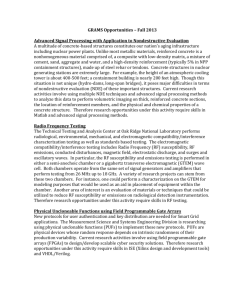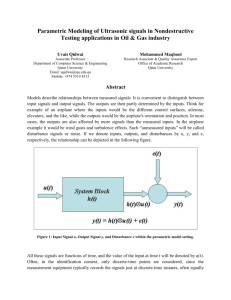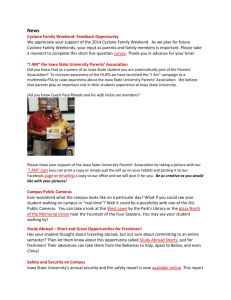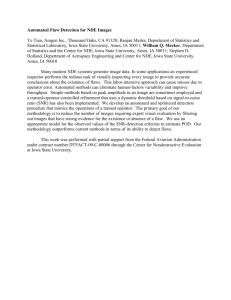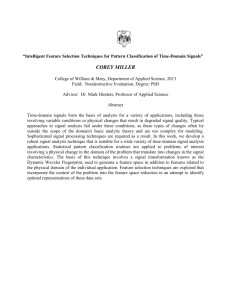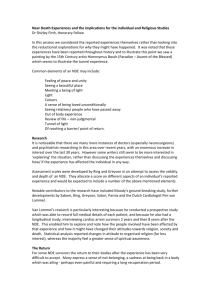template for mini case studies - Consortium for Science, Policy
advertisement
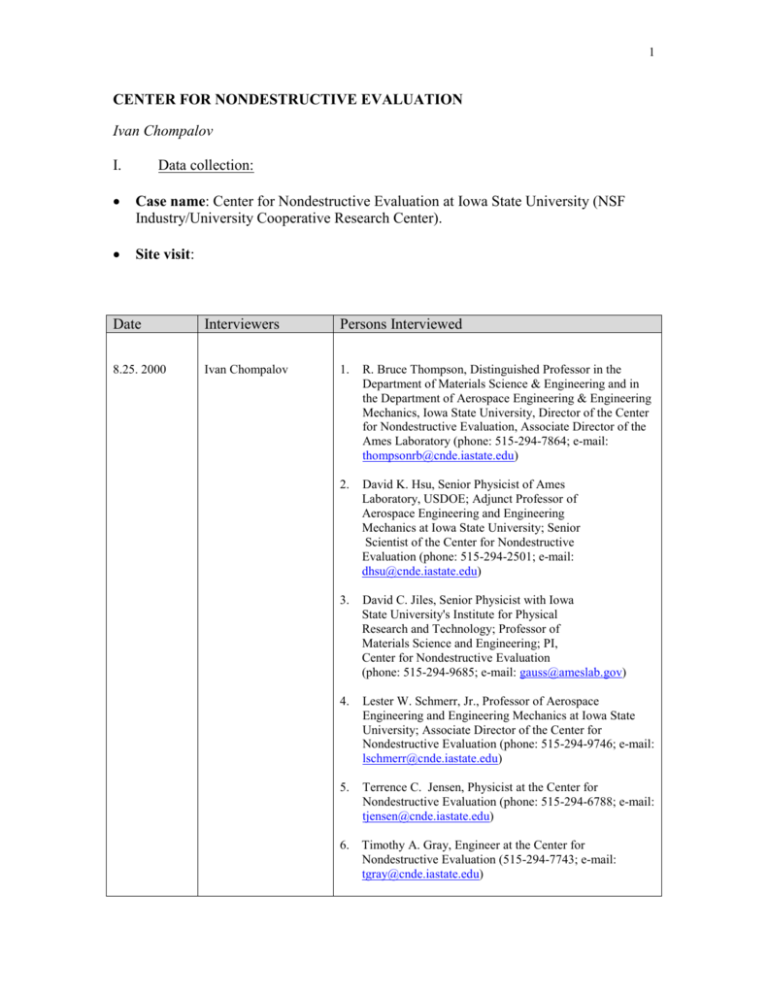
1 CENTER FOR NONDESTRUCTIVE EVALUATION Ivan Chompalov I. Data collection: Case name: Center for Nondestructive Evaluation at Iowa State University (NSF Industry/University Cooperative Research Center). Site visit: Date Interviewers Persons Interviewed 8.25. 2000 Ivan Chompalov 1. R. Bruce Thompson, Distinguished Professor in the Department of Materials Science & Engineering and in the Department of Aerospace Engineering & Engineering Mechanics, Iowa State University, Director of the Center for Nondestructive Evaluation, Associate Director of the Ames Laboratory (phone: 515-294-7864; e-mail: thompsonrb@cnde.iastate.edu) 2. David K. Hsu, Senior Physicist of Ames Laboratory, USDOE; Adjunct Professor of Aerospace Engineering and Engineering Mechanics at Iowa State University; Senior Scientist of the Center for Nondestructive Evaluation (phone: 515-294-2501; e-mail: dhsu@cnde.iastate.edu) 3. David C. Jiles, Senior Physicist with Iowa State University's Institute for Physical Research and Technology; Professor of Materials Science and Engineering; PI, Center for Nondestructive Evaluation (phone: 515-294-9685; e-mail: gauss@ameslab.gov) 4. Lester W. Schmerr, Jr., Professor of Aerospace Engineering and Engineering Mechanics at Iowa State University; Associate Director of the Center for Nondestructive Evaluation (phone: 515-294-9746; e-mail: lschmerr@cnde.iastate.edu) 5. Terrence C. Jensen, Physicist at the Center for Nondestructive Evaluation (phone: 515-294-6788; e-mail: tjensen@cnde.iastate.edu) 6. Timothy A. Gray, Engineer at the Center for Nondestructive Evaluation (515-294-7743; e-mail: tgray@cnde.iastate.edu) 2 7. John R. Bowler, Professor of Electrical and Computer Engineering at Iowa State University, PI, Center for Nondestructive Evaluation (phone: 515-294-2093; e-mail: jbowler@cnde.iastate.edu ) 8. Norio Nakagawa, Associate Physicist at the Center for Nondestructive Evaluation (phone: 515-294-9741; e-mail: nnakagaw@cnde.iastate.edu) 9. Chester Lo, Postdoctoral Research Fellow, Center for Nondestructive Evaluation (phone: 515-294-4140; e-mail: lo@ameslab.gov) 10. Changjiu Dang, Ph.D. Student, Center for Nondestructive Evaluation (e-mail: changj@cnde.iastate.edu) 11. Dong Fei, Ph.D. Student, Center for Nondestructive Evaluation (e-mail: dfei@iastate.edu) 12. Zach Nielsen, Undergraduate Student, Center for Nondestructive Evaluation (e-mail: znielsen@iastate.edy) 13. Brian Danowsky, Undergraduate Student, Center for Nondestructive Evaluation (e-mail: dano@iastate.edu) 14. Paul Petersen, Undergraduate Student, Center for Nondestructive Evaluation (e-mail: ppeters@iastate.edu) 15. Chris Temple, Undergraduate Student, Center for Nondestructive Evaluation (e-mail: ctrampel@iastate.edu) II. Technical Focus and Center History: The Center for Nondestructive Evaluation (CNDE) at Iowa State University is the only instance of an NSF Industry/University Cooperative Research Center (I/U CRC) in our sample. From an organizational and public policy viewpoint, it is a single-institution, multi-disciplinary, sponsor driven, and pre-competitive arrangement. Substantively, the center is engaged in research leading to quantitative nondestructive measurement techniques. From the outset CNDE was envisioned as an establishment with a more applied focus. The idea for a center originated at AMES laboratory where a core of researchers whose primary expertise was nondestructive evaluation and nondestructive testing had assembled. Two external developments speeded up the formation of the Center. The first was that in the early 1980s the Airforce and DARPA funding for nondestructive research and applications at AMES began to dwindle. The second was that about the same time NSF started the I/U CRC program and it became increasingly obvious to the core group of researchers at AMES that that was a good mechanism to 3 further develop nondestructive evaluation technology but also transfer it to industry and develop human capital that would be the mechanism of the transfer. So, a proposal was written and the center was officially awarded in 1985. It was created with funding predominantly from 14 industrial sponsors and to a lesser extent from NSF. The center is heavily involved in applied research. Currently it collaborates with about 24 companies including Boeing, GE, Siemens, Westinghouse, Pratt &Whitney, Sperry, Honeywell, Caterpillar. The major applications of CNDE research are in the aerospace industry, but also in car manufacturing, agriculture, animal science, and the biomedical sector. For the past several years, the center R&D activity has focused on seven broad projects or problem areas: engineering applications of ultrasonic measurement models; eddy current, thermal, and optical techniques; radiographic techniques; magnetic techniques; signal processing, pattern recognition, and AI; NDE for material properties; and NDE for composites. Two very successful companies have been spun off from the center and CNDE has had a substantial impact on the development of local, mainly small businesses. Thus, in some ways it is similar to the U of Michigan Center for Ultrafast Optics. There is a visible international dimension, more specifically focused on the creation of the World Federation of NDE Centers which was initiated by CNDE at ISU. This is also reflected in the staffing mix with both faculty and graduate students coming from a variety of countries (England, China, Japan). There is a strong educational component which spans all levels (K-12, community college, university graduate and undergraduate). This is also one of the channels for recruiting students. The effect on careers has been noticeable. In recent years several strong faculty recruitments have positioned CNDE as probably the strongest and largest such center in the world. The impact on student career paths has been mainly in preparing students for good jobs in industry, since the focus of the center is on hands-on experience in nondestructive evaluation and testing. The only slight drawback is that most students are too narrowly trained and thus being prepared for somewhat specialized careers. III. Magnitude: This is an assessment of the magnitude of the Center for Nondestructive Evaluation as of August, 2000. There have been some fluctuations for the past fifteen years, chiefly in the number of industrial sponsors. For the most part the constitution of the center in terms of personnel has been steady. Number and names of participating institutions: 1 university: Iowa State University. Number of research staff: 25 principal investigators (PIs), including 10 faculty and 5 adjunct faculty. All receive center support, supplemented by individual grants. Number of postdoctoral fellows: 2 4 Number of graduate students (research assistants): 32 Number of undergraduate students: 14 Supporting technical personnel: 9 Other staff (administrative and clerical): 8 Level of funding: Approximately $1,700,000 per year for 15 years. Additionally, the PI s use CNDE facilities to perform their individually supported research from various funding sources (DOD, DARPA, FAA, NASA, NIST, a number of industrial companies). Funding agencies: NSF, about 24 industrial contributors, and ISU. NSF provides a little over $50,000 per year of the core funding, while the rest comes from industrial contributors, Iowa State University, and other funding sources. There is a set membership fee for industrial firms, which is $35,000 per year. IV. Year 1985 1986 1987 1988 1989 1990 1991 1992 1993 1994 1995 1996 1997 1998 1999 2000 Outputs: Articles 50* 50* 50* 50* 50* 50* 50* 50* 50* 50* 50* 50* 50* 50* 50* na Technical Reports 1 1 1 1 1 1 1 1 1 1 1 1 1 1 1 na Patents Dissertations Theses 2 0 0 0 2 4 8 2 3 3 5 1 1 na na na na na na na na na na na na na na na na na na na na na na na na na na na na na na na na na na na Spin-off companies 0 0 0 0 1 0 0 0 0 0 1 na na na na na Notes: na=not available; *an estimate of the average number of CNDE publications per year, based on extrapolation of the publication records of 14 PI s and adjusted for coauthorship. 5 V. Impacts: Scientific impacts: As a world leader in the development of new NDE measurement techniques and interpretive models, CNDE has had a substantial overall impact on the development of the fairly narrowly specialized and small research area of nondestructive evaluation and testing. The scientific impact has been an accumulation of advances in the knowledge pertaining to NDE and NDT rather than a single, breakthrough discovery. Important strides have been made in all seven problem areas. Among the most outstanding achievements of center researchers are the development of models and simulations of ultrasonic and X-ray inspection and measurement; research on pulsed eddy current inspection; novel ways of image processing; techniques for detection of corrosion and buried layers; the elaboration of magnetic techniques for addressing inspection problems. Technical impacts: CNDE has been inherently involved in technology development and application of various techniques for NDE and NDT. The center has created a number of software tools for to make quantitative predictions of the results of an inspection. Several of them have been commercialized (the X-ray simulation software XRSIM; the ultrasonic inspection technique). CNDE has patented over 30 inventions and has had a number of licenses sold to various industrial companies. In addition, the center has been heavily involved in technology transfer both of software and hardware. Among some of the highlights in technology development have been the creation of enabling technology to establish the FAA Center for Aviation Systems Reliability in 1990 and the facilitation of the founding of the Engine Titanium Consortium in 1993 through the use of enabling technology from CNDE. Relations with industry: The relations of CNDE with industrial partners have been both active and pervasive, as might be expected given the center’s mission. Linkages have been set up at all levels of interaction (client-sponsored research, technology transfer, technical assistance, licensing, outreach). Center research has had wide applications in the fields of aviation, transportation, energy, manufacturing, agriculture, and recently in the biomedical sector. Education and outreach: Outreach and education have been outstanding dimensions of CNDE activity. A variety of programs have either been initiated or administered by the center. One major outreach effort at the state level was the establishment by CNDE of the Iowa Demonstration Laboratory for NDE Applications, which serves as a resource to small and medium-size manufacturers through demonstration of NDE technologies, educational seminars, and application guidance. Other outreach milestones are the facilitation of the formation of the World Federation of NDE Centers and the biannually published newsletter “CNDE News,” which reaches an estimated audience of 3000 readers. CNDE has been actively engaged in different forms of education at all levels. Among its notable achievements have been the establishment of an NDE engineering minor at ISU; the administration of the “NSF – 6 North Central Collaboration for Education in NDE/NDT” program; web-based educational programs in NDE for community college and for K-12. Student careers: The major impact on student careers has been the training they received in both theoretical and especially hands-on research in NDE and NDT, which has positioned them well for jobs in the area. The bulk of graduate students have gotten positions in industry and government laboratories. CNDE graduates can boast placements in some of the biggest and most prestigious companies (e.g. Boeing, Microsoft, Texas Instruments, McDonnell Douglas, General Electric). A specific feature of the way the center prepares students for the labor market is that most students are somewhat narrowly trained and thus better equipped for specialized careers. Collaboration: Research collaborations have chiefly involved interdisciplinary joint projects among CNDE participants from different Iowa State University departments. However, the most prominent aspect of collaboration has been the cooperation between the center and industrial companies or other universities and colleges on various ambitious programs. Thus, CNDE has collaborated with OSU in setting up and running the FAA Airworthiness Assurance Center for Excellence. CNDE also participates in the Engine Titanium Consortium, which brings together researchers from ISU and engineers from GE, Pratt & Whitney, and Allied Signal to develop and transfer inspection technology. Finally, CNDE collaborates with a number of community colleges by providing them training tools and facilitating student transfer.
